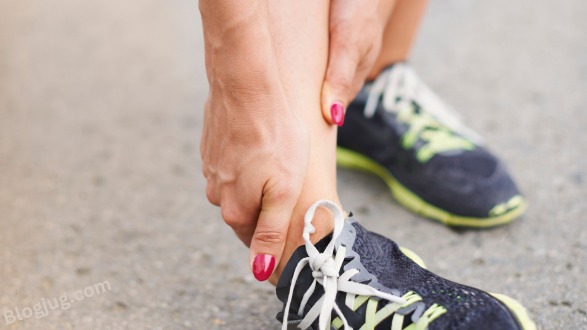Any type of pain or discomfort that affects any area of the ankle is referred to as ankle pain. At-home remedies for ankle pain typically include rest, ice, and over-the-counter pain relievers. You can avoid more injuries and strengthen your muscles with the aid of a physical therapy program. More severe pain is treated by providers with surgery, injections, and braces and splits.
What is ankle pain?

Any type of pain or discomfort that affects any area of the ankle is referred to as ankle pain. There are several causes of ankle pain. The most frequent reasons are normal wear and tear, arthritis, and injuries. Anywhere near the ankle may hurt or feel stiff, depending on what’s causing it. Your ankle may swell and become immobile.
Ankle pain typically improves with rest, ice, and over-the-counter pain relievers. Physicians can treat arthritis and injuries. Many times, treatments don’t require surgery. Surgery is necessary, though, if the injury is serious—such as a shattered ankle bone—or if nonsurgical treatment is ineffective for your ankle pain. A physical therapy (PT) program can also aid in your recovery if you’ve had surgery or an ankle injury. PT helps to build stronger muscles in your ankles and feet. Both pain relief and injury prevention are possible with the therapy.
What are the parts of the ankle?
A component of the musculoskeletal system is your ankles. They aid in standing, balancing, and movement by supporting the weight of your body. You can point, flex, twist, and move your foot side to side thanks to your flexible ankle joint.
The ankle is formed by the meeting of the (talus) the foot bone, and the (tibia and fibula) lower leg bones. These bones are held together by ligaments. The foot and ankle are made of a complicated structure made up of muscles, tendons, and other soft tissues. Because of this complexity, the ankle is particularly vulnerable to damage.
How common is ankle pain?
Ankle injuries and pain are extremely common. Ankle discomfort is more likely to occur if you:
1. Are older than 65.
2. Engage in sports or physical activities that require leaping, swaying, or abrupt direction changes.
3. Become obese or overweight.
Possible Causes
Which conditions typically result in ankle pain?
Ankle pain can arise from several injuries and conditions. Many common injuries can result in ankle discomfort, including the following:
1. Bursitis: Bursae are sacs filled with fluid that cushion your bones when they move. When these sacs become irritated and inflamed, bursitis results.
2. Fractures: Bones can fracture due to an accident or injury. There are several degrees of ankle fractures. Any bone in the ankle joint may be affected by a broken ankle. Ankle soreness and edema result from a broken ankle.
3. Sprains: Ankle discomfort is frequently caused by sprained ankles. An ankle sprain results from a rip or tear in the ligaments. Ankles that are twisted or sprained are caused by the ankle rolling violently out of its natural position.
4. Tendonitis: Tendonitis is a soft-tissue injury characterized by irritated and swollen tendons. Tendons are what join muscles and bones. A tendon may rupture from Sometimes (such as an Achilles tendon rupture). Repairing a damaged tendon may require surgery.
Ankle discomfort can result from any number of illnesses, ailments, and situations. Among them are:
1. Arthritis: Ankle arthritis can cause pain and stiffness in the ankle joint. When cartilage, the tissue in joints that cushions bones, deteriorates, arthritis results. Bones grind together as a result of the breakdown. Arthritis can be caused by overuse or injuries, and it is more common in those over 65. Ankle pain can be caused by a variety of arthritis kinds. Osteoarthritis and rheumatoid arthritis are common varieties.
2. Flatfoot: Ankle and foot pain and edema might result from a very low arch or no arch at all. The condition arises when children’s arches don’t grow normally as they get older.
3. Gout: A gout is a form of arthritis caused by an accumulation of uric acid in the body. Uric acid usually excretes from the body as urine. Crystals formed by too much uric acid accumulate in the joints. Ankle gout can be excruciatingly painful.
4. Infection: Ankle joint swelling and pain can be caused by many infections, such as cellulitis. A staph infection can lead to osteomyelitis, an infection of the bone.
How will my doctor identify the source of my ankle pain?
Your doctor will examine your ankle and foot. The providers look for bruises, discomfort, and swelling. Testing is dependent on where the pain is located and whether you have recently sustained an injury. A scan for magnetic resonance imaging (MRI), computed tomography (CT), or X-rays may be prescribed by your physician. With the help of these tests, your physician can examine soft tissues and bones to look for injury.
You could require a biopsy if your doctor believes you have an infection. To screen for germs, your physician takes a sample of tissue and sends it to a lab.
Care and Treatment
How can I get rid of my ankle pain?
The majority of ankle pains resolve with rest, ice, and over-the-counter (OTC) painkillers. When it comes to treating ankle pain at home, heed the advice of your physician. The RICE approach (rest, ice, compression, and elevation) can be suggested by your healthcare physician. See your provider if the pain is severe or if it persists after receiving at-home care for a few days.
Typically, the following are used at home to treat ankle pain:
1. Rest: If you have a sprain or other similar injury, you should take some time off from walking. To find out how much sleep is optimal, speak with your healthcare provider. You might be able to move around without hurting your ankle by using crutches or walking boots.
2. Ice: Every few hours, massage the affected area with ice or a cold compress for 15 to 20 minutes to minimize swelling.
3. Compression: To lessen inflammation, ask your doctor about applying an elastic bandage on your ankle. Be careful Don’t wrap it too tightly.
4. Elevation: Swelling is lessened when you rest with your ankle up above your heart. Another option is to attempt sleeping with your foot raised at night.
5. Over-the-counter pain medication: NSAIDs, or nonsteroidal anti-inflammatory medicines, are effective at reducing swelling and pain. Be sure to speak with your doctor before using any medications.
6. Supportive footwear: Ensure that your ankles and feet get enough support from your shoes. Steer clear of sandals, flip-flops, and very loose shoes. When participating in sports, it’s extremely crucial to wear appropriate footwear. Sports like basketball and volleyball can cause injuries to the ankles, particularly if the proper footwear isn’t worn.
How are ankle pains treated by medical professionals?
The majority of ankle injuries recover with at-home care. Surgery can be necessary for more serious wounds. How to treat ankle discomfort relies on its cause. The following are typical therapies for ankle pain:
1. Braces and splints: Your ankle may be stabilized and discomfort relieved with an ankle brace. various activities are better suited for various braces. Request that your supplier suggest one that best suits your way of life.
2. Joint aspiration: Your doctor will use a needle to remove extra fluid from the joint during this treatment. Pain and swelling are reduced by joint aspirations.
3. Medications: Many kinds of drugs can ease ankle discomfort and reduce inflammation. Medication for gout and arthritis can greatly lessen pain and swelling.
4. Orthotic inserts: Inserts that fit into your shoes are called orthotics. They can be made specifically for your feet by your provider, or you can purchase them from the store. Orthotics provide the foot with stability and support while guaranteeing correct alignment.
5. Physical therapy: Your ankle-supporting muscles will become more flexible and strong with the aid of a personalized physical therapy program. Your physical therapist will make a personalized PT plan for you that includes stretches and exercises. Make sure to perform the stretches and workouts as directed regularly.
6. Steroid injections: Your doctor will inject anti-inflammatory drugs straight into your joint using a needle. Cortisone injections lessen pain and inflammation.
7. Surgery: A multitude of surgical techniques for the ankle can mend injured tendons or ligaments. Certain methods treat flat feet or reduce arthritic discomfort. Pain can be reduced and functioning can be restored with ankle joint replacement surgery.
How can I prevent ankle pain?
Ankle pain might not always be avoidable. However, by keeping yourself well, you can preserve the strength of your tendons, ligaments, and bones. To avoid injury-related ankle pain, you should:
1. Warm up properly: Before working out, stretch. Warm muscles and soft tissues (such as ligaments and tendons) are less prone to injury.
2. Stop if you feel pain: Don’t put up with suffering. Take a break if a certain movement or activity is bothersome. If the pain doesn’t go away, consult your doctor. Pain during exercise may make pre-existing injuries worse.
3. Strengthen other muscles: You can support your ankles and lower your chance of damage by maintaining the strength of your other muscles.
4. Maintain a healthy weight: Excessive weight bearing puts undue strain on your ankles and other joints.
When to Call the Doctor
What time is best to call my doctor if I have ankle pain?
Make an appointment with your doctor if:
1. Your ankle cannot support any weight.
2. A fever or redness where the skin meets the touch could indicate an infection.
3. Swelling and pain appear out of the blue.
4. After receiving at-home treatment for two to three days, ankle pain is severe or remains unabated.
A note from Blogjug
Numerous ailments and injuries can cause ankle pain. Walking may become impossible due to discomfort, stiffness, and swelling. The majority of ankle injuries heal with at-home therapies including resting and elevating the injured foot. Generally, ankle discomfort doesn’t require surgery. See your provider if the pain is severe, you have a lot of swelling, or it doesn’t go away after a few days. Several non-invasive procedures can assist you in getting back on your feet.









2 thoughts on “Managing ankle Pain: Tips for Relief”